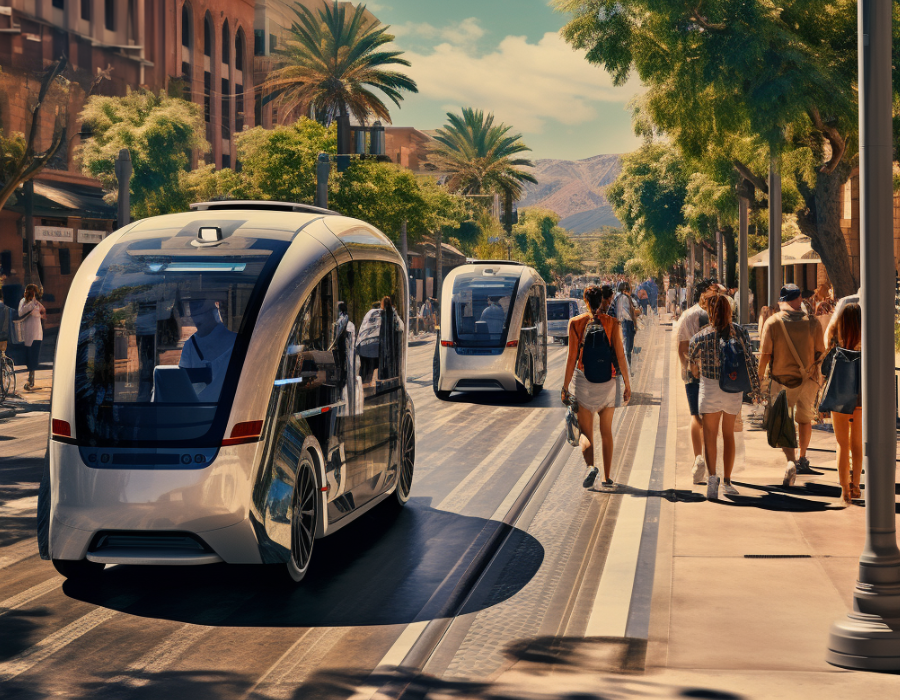By Rita Mouchi
Phoenix, Arizona. As a growing metropolis in the heart of the desert, the city has long been synonymous with car culture. With a staggering seven million cars, seven parking spots to each car with a utilization rate of just five percent, and a seemingly endless grid of highways and parking lots, it’s evident that the city has been designed around automobiles rather than its residents. However, this reliance on cars has come at a cost, contributing to air pollution, urban sprawl, and a lack of community cohesion.
As the fifth largest city in the U.S., Phoenix has great transformative potential but faces unique challenges exacerbated by its desert climate, including scorching temperatures reaching record highs. With over 100 days of poor air quality annually — and the most recent summer season hitting 110 degrees for 54 consecutive days — the need for a paradigm shift in transportation infrastructure has never been more urgent.
 What if we were to draw inspiration from other carefully planned cities across the globe, amalgamating their successful elements into a tailored formula for Phoenix, allowing our city to evolve into a thriving hub of innovation and sustainability? What if we imagined a system, a ‘Vehico-System’ if you will, aimed at redefining public transportation in Phoenix? Leveraging existing technologies such as autonomous vehicles (Waymos) and incorporating future innovations like eVTOLs (electric vertical takeoff and landing) transportation, we could create a system that offers a hyper-efficient mobile metropolis that would prioritize the needs of its residents over individual cars. It could be a system that provides constantly moving vehicles for the public and requires less parking.
What if we were to draw inspiration from other carefully planned cities across the globe, amalgamating their successful elements into a tailored formula for Phoenix, allowing our city to evolve into a thriving hub of innovation and sustainability? What if we imagined a system, a ‘Vehico-System’ if you will, aimed at redefining public transportation in Phoenix? Leveraging existing technologies such as autonomous vehicles (Waymos) and incorporating future innovations like eVTOLs (electric vertical takeoff and landing) transportation, we could create a system that offers a hyper-efficient mobile metropolis that would prioritize the needs of its residents over individual cars. It could be a system that provides constantly moving vehicles for the public and requires less parking.
This could begin by reimagining the city’s infrastructure and dedicating a strategic portion of the existing grid system to this Vehico-System. As an example, claiming a transit lane every second main street within the grid system, as well as repurposing the existing HOV lanes for this people-centered system — to include autonomous vehicles, buses, and potentially a rail line — would provide a reduced reliance on private cars. This could not only alleviate traffic congestion but also free up valuable real estate currently occupied by empty parking lots.
But what about the convenience of using your own personal vehicle? This Vehico-System could tackle the inefficiency and unreliability of traditional public transportation. By implementing a hyper-connected network that ensures users never have to wait more than five minutes in uncomfortable outdoor conditions, the system would need to enhance accessibility and convenience. Through the integration of AI-assisted apps, users could seamlessly navigate the city, optimizing routes for speed, cost, comfort, and safety.
 The system would promote a much-needed pedestrian-friendly infrastructure, addressing the city’s alarming rate of pedestrian fatalities. By redesigning shaded and safe pedestrian routes and reclaiming ground floors of buildings for public use, Phoenix can become a more walkable and connected city, fostering community cohesion and improving public health.
The system would promote a much-needed pedestrian-friendly infrastructure, addressing the city’s alarming rate of pedestrian fatalities. By redesigning shaded and safe pedestrian routes and reclaiming ground floors of buildings for public use, Phoenix can become a more walkable and connected city, fostering community cohesion and improving public health.
Beyond practicality, the Vehico-System could aim to transform public transportation into a premium experience. By strategically pairing transit stations with popular destinations, the system becomes an amenity, attracting both tourists and commuters. This shift in perception from public transportation as a last resort to a sought-after mode of travel contributes to positive densification and sustainability, ultimately reimagining Phoenix’s living culture. Future developments could be influenced to build around these transport hubs.
And why stop there? The Vehico-System could extend connectivity beyond city limits, linking neighboring cities through rail networks. By facilitating regional transportation, Phoenix can foster economic growth and cultural exchange while reducing dependence on individual cars and highways.
In the pursuit of realizing the vision of a system like this, the concept of Public-Private-Partnerships (P3s) emerges as a pivotal strategy. By harnessing the strengths of both the public and private sectors, P3s could offer a pathway to expedite the implementation of innovative transportation solutions that catalyze positive change to shape the city’s future as a model of sustainable urban mobility.
Ultimately, the Vehico-System could represent a fundamental shift in how we envision transportation in Phoenix. By prioritizing the needs of residents, reducing reliance on cars, and fostering community connectivity, a system like this could pave the way for a more sustainable, livable, and vibrant city.






